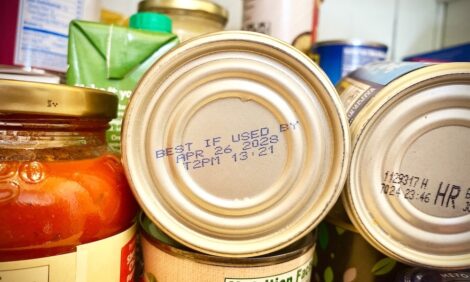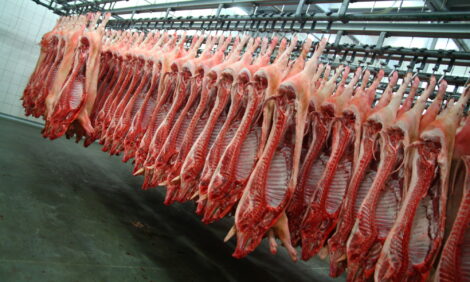



US Situation and Outlook Report - May 2001
By U.S.D.A., Economic Research Service - This article is an extract from the May 2001: Livestock, Dairy and Poultry Situation and Outlook Report, highlighting Pork Industry data. The reports indicates US pork production will rise slowly through this and next year partly due to financial conditions in 1998/99 causing many small producers to leave the industry and new regulations which are making it more difficult for larger and mid-sized producers to expand.| Meat and Poultry Production To Rise Slightly in 2002 |

|
Although red meat and poultry supplies are record large, continued relatively strong domestic and foreign demand is forecast to maintain prices. Prices for both fed and feeder cattle are expected to post modest gains as supplies continue to decline. Wholesale broiler dark meat parts prices are also expected to post modest gains due to continuing strength in exports.
Increased pork production will likely pressure hog prices downward.
Retail prices for red meat and poultry are expected to rise very modestly in 2002. Despite a continuing declining supply of beef, retail beef prices are expected to increase 1-2 in the face of large competing meat supplies.
The modest increase in pork supplies is expected to keep the retail pork rise very modest (1-3 percent) as the farm-retail price spread widens. Poultry prices (BLS price index) may rise 1-3 percent, while eggs are about unchanged after posting an expected 5-6 percent rise in 2001.
| Pork Production To Rise Slowly |
Expansion more complicated
Pork producers are gradually expanding production this year and are expected to continue the slow rate of expansion through 2002. The changing industry structure and financial problems in
late 1998 and 1999 have contributed to a muted response to favorable returns in 2000 and the
first-half of 2001. Many smaller producers exited the industry in the late 1990s. Of the smaller
producers left, many may still be recovering from financial problems of late 1998 and early 1999.
To expand production, larger and mid-sized producers face a more complicate process now than
in the recent past. Expansion processes now include securing financing, obtaining building and
waste management permits from State and local authorities and hiring and training staff. In
addition, vertical coordination through either marketing or production contracts are currently
prevalent, rather than the spot market sales as in past years. The factors that complicate
expansion today, are likely those that are muting the peaks and valleys of the hog production
cycle.
Production and weights increase
Pork production in 2002 is forecast at 19.7 billion pounds, up 3 percent from this year. Hog
slaughter will likely be up about 2 percent and the average dressed weight will likely be a pound
heavier. The March Hogs and Pigs report indicated the inventory of all hogs and pigs was up 2
percent from a year earlier. The number of hogs kept for breeding was up 1 percent, consistent
with the March-August farrowing intentions (up 1 percent from actual farrowings a year ago).
Farrowings during September 2001-June 2002 are expected to be up 1-2 percent continuing on the slow expansion track. Pigs per litter are expected to rise very modestly (less than 1 percent)
resulting in pig crop increases during June 2001-May 2002 of 2-3 percent.
Prices to move slightly lower
Hog prices are expected to average in the low- to mid-$40s per cwt in 2002, compared with the
mid-$40s this year. Competing poultry meat supplies will continue to be large. Retail pork prices
are expected to rise 1-3 percent in 2002, about the same increase expected this year. Record
retail beef prices increases the competitive position of pork and provides less incentive for
retailers to feature pork.
| U.S. Pork Exports To Remain Steady |
Exports static
U.S. pork exports are forecast at 1.4 billion pounds in 2002, about the same as this year. Major U.S. export markets will continue to be Japan, Mexico, and Canada, with approximate export shares of 50 percent, 20 percent, and 10 percent. Export and production forecasts for 2001 and 2002 together imply that exports will average about 7 percent of production, compared with 2 percent in 1991 and 1992.
The 2001 pork export forecast was increased to 1.405 billion pounds due to very large first quarter flows of pork products, to Japan in particular. Since the beginning of the year, Japan’ s imports of U.S. pork have averaged 65 million pounds per month, 30 percent higher than last year. Japanese Government data suggest that large imports from the United States and Canada were the result of several interacting factors: attractive North American prices of desirable pork cuts (hams and shoulders, in particular); a lower first-quarter hog slaughter and thus higher retail prices of domestic pork cuts; a willingness of importers to pass along lower prices to Japanese consumers; and finally, a likelihood of changed stocks accumulation behavior in Japan.
Lower Japanese retail prices
Japanese Government price and import data suggest that Japanese traders imported large quantities of U.S. and Canadian frozen shoulders and hams in the first quarter. These imported cuts traded in Japan at prices almost 20 percent lower than a year ago. Traders appear to have passed along lower prices to consumers; retail prices of imported shoulders and hams averaged almost 20 percent lower than the same period in 2000. Lower retail prices of imported cuts, together with 5 percent higher retail prices of domestic pork encouraged Japanese consumers buy North American cuts.
Data for pork ending stocks suggests that stock accumulation patterns may be changing. In the first quarters of both 2000 and 2001, Japanese pork ending stocks accumulated much faster than in past years. Last year, rapid stock accumulation in the first quarter was followed by a rapid drawdown in April, for the Golden-Week holidays. Stock levels between May and November 2000 maintained relatively constant levels until dipping in December. Such a pattern-- rapid first-quarter accumulation, a drawdown in April, followed by steady stock levels until December--is a clear departure from stock accumulation/drawdown patterns of past years. Changed stock accumulation behavior in Japan may contribute to the explanation for very strong first-quarter imports.
Imports remain static
U.S. pork imports are forecast at about 1 billion pounds in 2002. The import forecast for 2001 was lowered to 965 million pounds to reflect the 10-week ban on imports from the European Union due to the FMD outbreak. Resumption in imports from Denmark likely will boost second half imports.
Integration with Canadian Industry
The trend toward higher imports that the United States has witnessed in the past five years is a reflection of the expanding Canadian pork industry, and the growing integration between the U.S. and Canadian pork industries. The integration trend is likely to continue and, as a result, Canada’ s share of U.S. imports will continue to increase, and Denmark’ s share will decline. In 2000, Canada accounted for 76 percent of U.S. pork imports; Denmark accounted for 15 percent. By comparison, Canada’ s share of U.S. imports was 49 percent in 1990, while Denmark’ s share was 30 percent.
Integration of the North American pork industry is also apparent from the Canadian perspective. Last year, the United States accounted for 90 percent of Canadian pork imports; while in 1990, the U.S share of Canadian imports was 80 percent. Canada however, remains a net exporter of pork to the United States. In 2000 Canada exported over 535 million pounds more pork than it imported from the United States, on a product weight basis. The United States, on the other hand, is a net importer of pork from Canada. In 2000, the U.S. imported 595 million pounds more pork than it exported to Canada, on a carcass weight basis.
Live imports ahead
Live hog imports are forecast at 4.7 million head for both 2001 and 2002, compared with 4.36 million head in 2000. The rapid evolution of both a feeder pig export sector in Canada, and a hog finishing sector in U.S. Corn Belt States traditionally given to farrow-to-finish operations, has been the primary factor in increased import forecasts. Continuing expectations for low feed prices are also contributing to the increased forecast. First-quarter 2001 live hog imports from Canada were over 1.2 million head, 58 percent of which were feeder animals.
More information including figures and graphs is avaiable in the full 45 page report, see below for details.
Links
For more information view the full Livestock, Dairy and Poultry Situation and Outlook (pdf)Source: Livestock, Dairy and Poultry Situation and Outlook - U.S. Department of Agriculture, Economic Research Service - May 30, 2001








